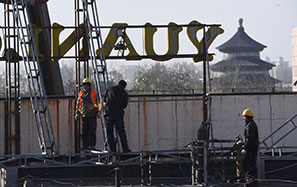Apple upsets the risk-reward ratio cart

Apple has been in all sorts of hot water recently. It has had to contend with charges over troubling labor practices at its assembly facilities in China, as well as not doing enough for employment in the United States.
That America's most iconic company - and the world's most valuable, based on its current stock market capitalization - had no manufacturing operations at home seemed to contravene the much-acclaimed rebirth of US manufacturing. Apple finally relented and announced plans to start manufacturing some of its Mac computers at a so-far-not-specified US location.
However, the goodwill from that announcement proved short-lived. Apple, like other US multinationals, was soon accused of being too artful in booking its profits in locations that offer very low rates of taxation. And yet, despite the twists and turns of the Apple saga over the past year or so, the main issue at stake from the point of American people and taxpayers has not even begun to be addressed.
The US, which is by far the company's largest market, is not just where a large part of Apple's profit is generated. It is also the place where the initial innovation was funded - but not by Apple. Many of the revolutionary technologies that make the iPhone and other products and services "smart", such as the Internet, GPS, touch-screen display and its voice-activated personal assistant, Siri, were funded by the US government.
The company based in Cupertino, California, did not just benefit from the US government-funded research activities. It also received its early stage funding from the US government's Small Business Investment Company program.
Apple may not be known as top financial company, but it can be considered one of the most successful arbitrageurs in history. Arbitrageurs typically take advantage of price difference between two or more markets. Apple put a new twist on arbitrage, and masterfully put together a lot of technologies funded by the US government (and hence the American people) and exploited them in its own products.
But the issue is significant beyond the fortunes of one company, because Apple is not the only Silicon Valley-based company to do so - not by a long shot. Others, such as Google, whose search algorithm was funded by the National Science Foundation, have also profited immensely in similar fashion.
In fact, many new economy-type companies that like to portray themselves as the heart of US "entrepreneurship" have successfully surfed the wave of US government-funded investments. Hence, the secret to Silicon Valley's success was the government's active and visible hand, in stark contrast to the Ayn Rand/Adam Smith folklore often bandied about.
The US government, through the Defense Advanced Research Projects Agency and other initiatives, stands out worldwide for its astoundingly positive track record in funding true innovation. This includes the government's most recent claim to fame, its steadfast financial support of (controversial) shale gas and fracking technologies, begun more than three decades ago during the otherwise much-maligned Jimmy Carter administration.
In a business context, the role of the US government is often portrayed as one safeguarding against market failure. But that traditional understanding must be widened to include the active - and often catalytic - role that the US government's risky investments have played for technology-based corporations.
While many US economists have focused on market failures to justify government intervention, the US government's range of "mission-oriented" investments, which has funded development projects such as the Internet, points to a role far bigger than a mindset devoted to just fixing problems. These technology activities do require a vision, a mission and a plan - and lots of money for upstream research through to downstream commercialization.
It is not by accident that the National Institutes of Health spends $31 billion a year on supporting innovation in biotechnology and pharmacology. Academic predilections and conventions notwithstanding, such an investment can hardly be considered as just "nudging" a sector.
The crucial question to be answered is not just whether the present system is geared toward the government showing a lot of entrepreneurial courage, but why it is systematically badmouthed despite its many successes. And an even bigger question for American taxpayers is whether such support leads to a "parasitic" innovation ecosystem.
Consider Apple. Despite benefiting directly from taxpayer-funded technologies, it has strategically "underfunded" the tax purse on which it has in the past directly depended. Apple set up a subsidiary in Reno, Nevada, a state without a corporate income or capital gains tax. It channeled a portion of its US sales there, instead of including it in the revenues it reported in California, where it has its headquarters. Apple reportedly saved $2.5 billion in taxes.
While such tax loopholes need to be plugged, the tax system is not the only way to recoup the benefits that the US government helped trigger with its investments in risky innovations.
What to do to make the field of technology funding less parasitic? Part of the solution must entail the government getting a "reward" for the high-risk areas it funds directly. Wherever technological breakthroughs have occurred as a result of targeted public sector interventions, there is potential for the government, over time, to reap some of the financial windfall. This can occur by retaining a "golden share" of the royalties from patents, retaining a portion of equity, or also administering so-called income-contingent loans, similar to those now offered to students.
Clearly, the role of the government is not to run commercial enterprises, but to spark innovation in strategic areas. But given the ever-tighter public budgets, unless an innovation fund can be regularly replenished with some returns from the successes, innovation itself would be under threat.
The government should never have an exclusive license on or hold a large enough portion of the value of an innovation so that its commercial use is deterred in any form or fashion. But at the same time, it is self-defeating even for private-sector innovation if private companies are the only ones to gain all the reward. Indeed, the same criticism made about banks - socialization of risk, privatization of reward - holds for the innovation economy.
If the US wants to continue to be a leading technology nation providing a good quality of life to all its citizens, then it must urgently redress the grave imbalance in the risk-reward ratio governing the technology sector.
The author is a professor of economics and RM Phillips Chair in Science and Technology Policy at University of Sussex, and a contributor to The Globalist.com.


















